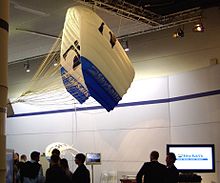SkySails
This article's factual accuracy may be compromised due to out-of-date information. (May 2016) |

SkySails GmbH & Co. KG is a Hamburg-based company that sells kite rigs to propel cargo ships, large yachts and fishing vessels by wind energy. Ships are pulled by an automatically-controlled foil kite of some hundreds of square meters. For multiple reasons, they give many times the thrust per unit area of conventional mast-mounted sails.
The systems save fuel, and reduce carbon emissions and shipping costs, but a market failure is slowing their adoption.[1][2]
Technology
The SkySails propulsion system consists of a large foil kite, an electronic control system for the kite, and an automatic system to retract the kite.
The kite, while 1-2 orders of magnitude larger, bears similarities to the arc kites used in kitesurfing. However, the kite is an inflatable rather than a ram-air kite.[citation needed] Additionally, a control pod is used rather than direct tension on multiple kite control lines; only one line runs the full distance from kite to ship, with the bridle lines running from kite to control pod. Power to the pod is provided by cables embedded in the line; the same line also carries commands to the control pod from the ship.[3]
The kite is launched and recovered by an animated mast or arm, which grips the kite by its leading edge. The mast also inflates and deflates the kite. When not in use, mast and deflated kite fold away.[3]
A conventional ship with a SkySail-system burns less fuel, and has two propulsion methods, making it a type of hybrid vehicle. SkySail kite propulsion from upper wind power is a traction use of high altitude wind power. Up to 100 million tons of carbon emissions every year could be saved by widespread use of SkySails technology, according to the International Maritime Organization.[2]
Other companies, such as California-based KiteShip, have built similar technology.[1]
Operational history

The Wessels Shipping Company (w:de:Reederei Wessels) entered into a partnership with SkySails to pilot and test the system on their ship MV Micheal A. in 2007. They then ordered further systems, the first of which was retrofitted to the MV Theseus (see image).[4]
MS Beluga SkySails was the first ship to be built to use the system, and the first using a production model. The 132 m, 10,000 tonne vessel was fitted with a 160-square-metre (1,700 sq ft) kite and launched 17 December 2007 and departed the northern German port of Bremerhaven to Guanta, Venezuela in January 2008.[5]
The ship completed its journey on 13 March 2008 after sailing from Germany to Venezuela, then to the United States, and ultimately arriving in Norway.[6] While the kite was in use, the ship saved an estimated 10-15% fuel, $1,000 to $1,500 per day.[5]
The annual savings in consumption on windy routes is on the order of about 5.5%, as determined by the EU-funded Life project WINTECC (duration four years).[7][8][9]
In early 2010, the company announced that it had sold one of its 160m² systems to be installed on the Maartje Theadora, the first application of the SkySails system on a fishing trawler. The vessel is described as Germany's largest fishing ship, and the kite is expected to reduce fuel costs on the runs to fishing grounds along the African coasts or the South Pacific.[10]
Business
The company was founded in 2001 by engineers Stephan Wrage and Thomas Meyer. In addition to the headquarters in Hamburg, a test facility was set up in Wismar. In the weak economy of 2012, a time of low investment by shipping companies, the company laid off half of its 80 employees. As of January 2016, it employs 50 people.[11] SkySails sources its kites from North Sails New Zealand.[11]
The company, while technically successful at cutting shipping costs and carbon emissions, has faced economic difficulties.[1][2]
There’s a structural problem slowing down the process: ship owners (who have to make the investment) often don’t pay for the fuel – that’s the charterer’s duty. The charterer on the other side doesn’t charter the ship for long enough a period to make low-carbon technologies pay back.
— Henning Kuehl, head of business development at SkySails[2]
Fuel costs mostly get passed onto the shipper so we see little use in installing potentially expensive, untested technology to which we see no other benefit. Basically I am interested but will not be the first to try it on a large scale.
— Anonymous ship owner[1]
A complete lack of regulation for carbon emissions from shipping and low fuel prices adds to these difficulties.[2]
See also
References
- ^ a b c d Skysails, Captain John Konrad, Mariner's Weather Log, April 2009, Volume 53, No. 1, National Weather Service
- ^ a b c d e Let’s Go Fly a Kite – SkySails and Climate Change, by Deviyani Misra-Godwin, November 4, 2016, Technology and operations management course, Harvard Business School
- ^ a b Airborne Wind Energy Systems, a review of the technologies, A. cherubini, A. Papini, R. Vertechy, M.Fontana, Renewable and Sustainable Energy Reviews, 2015
- ^ http://www.skysails.info/english/skysails-marine/references/wessels/
- ^ a b "Ship kites in to port". Nature News. Nature. Retrieved 1 January 2016.
- ^ "Kite-Driven Beluga Skysail Completes 12,000 Mile Journey and Proves Concept". Triple Pundit. 2008-03-14. Retrieved 2010-05-19.
- ^ Projekt WINTECC Layman's Report (3.1 SkySails-System) (PDF-file). Retrieved May 27, 2011 Archived March 24, 2012, at the Wayback Machine
- ^ Skysails Performance Calculation (Operating days at sea). Retrieved May 27, 2011 Archived January 6, 2009, at the Wayback Machine
- ^ Beluga Group, N-Series Main engine data - Speed & consumption HFO. Retrieved May 27, 2011 Archived January 22, 2011, at the Wayback Machine
- ^ "Fishing trawler will be powered by a 160m2 kite propulsion system". SurferToday.com. Retrieved 27 June 2010.
- ^ a b "SkySails GmbH - About SkySails". SkySails GmbH. Retrieved 1 January 2016.
